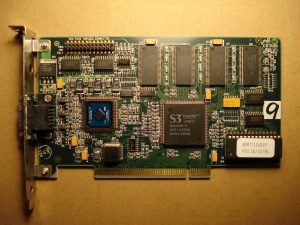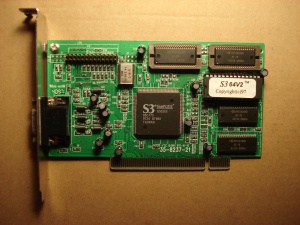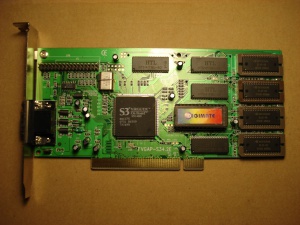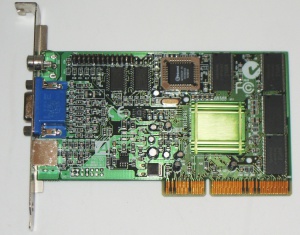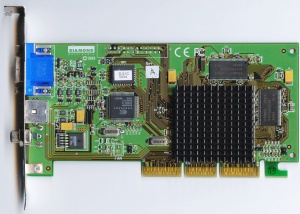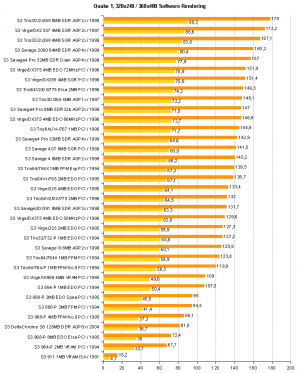Difference between revisions of "S3"
Idspispopd (talk | contribs) (→Related links: - VOGONS thread) |
Michael Dale (talk | contribs) m (→S3 801, 805, 805i) |
||
| Line 10: | Line 10: | ||
Like the 911 but with 24-bit true-color acceleration. | Like the 911 but with 24-bit true-color acceleration. | ||
=== S3 801, 805, 805i === | === S3 801, 805, 805i === | ||
| − | These were S3's first mainstream DRAM VESA Windows accelerators (16/256-color, high-color acceleration). Offered good value for the money at | + | These were S3's first mainstream DRAM VESA Windows accelerators (16/256-color, high-color acceleration). Offered good value for the money at the time. Available for ISA and VLB. The 805i used interleaved memory. |
| + | |||
=== S3 928 === | === S3 928 === | ||
Less buggy version of 924 with 24/32-bit true-color acceleration, DRAM or VRAM | Less buggy version of 924 with 24/32-bit true-color acceleration, DRAM or VRAM | ||
Revision as of 13:54, 2 January 2016
S3 Graphics, Ltd is a graphics hardware manufacturer founded in January 1989. Their proprietary API's were S3D for DOS and Windows 9x and MeTaL for Windows.
*S3 chip sets were very popular among low-end graphic hardware manufacturers. Sometimes standard S3 drivers won't work on such cards. Use FCC ID to confirm the graphic card's origin.
Contents
[hide]Chips
S3 911, 911A
S3's first Windows accelerators. VRAM based (16/256-color, high-color acceleration). Released June 10, 1991.
S3 924
Like the 911 but with 24-bit true-color acceleration.
S3 801, 805, 805i
These were S3's first mainstream DRAM VESA Windows accelerators (16/256-color, high-color acceleration). Offered good value for the money at the time. Available for ISA and VLB. The 805i used interleaved memory.
S3 928
Less buggy version of 924 with 24/32-bit true-color acceleration, DRAM or VRAM
S3 805p, 928p
Adds PCI support
S3 Vision
High performance GUI accelerators during 1994 and 1995. The family includes the 864, 868, 964 and 968 chips. The 9xx series uses VRAM memory instead of fast-page DRAM, enhancing memory performance and improving high-resolution GUI performance. The x68 chips include motion video acceleration features including color space conversion and video scaling.
S3 Trio 32/64
An evolution of the 864. The name refers to the integration of 3 components into one ASIC: RAMDAC, graphics core and clock generator. Higher integration reduces overall product cost.
Trio64 variants are popular for DOS gaming due to their high compatibility and good speed.
S3 ViRGE
The ViRGE is the first S3 chip with 3D acceleration support and launched in 1996. Aside from the 3D hardware, it is quite similar to the Trio64V+. These cards typically come equipped with 2-4MB RAM. S3 created the S3D API to program directly for the ViRGE accelerators although they also support Direct3D 3+.
There are several variants. The original ViRGE (marked 325), the ViRGE VX, ViRGE DX, ViRGE GX, ViRGE MX, ViRGE GX/2, Trio3D and Trio3D/2X. VX is slower at 3D but uses VRAM memory to somewhat improve high-resolution GUI performance. DX and GX are the second generation and GX supports SGRAM. MX was designed as a power-effecient mobile graphics solution, yet it made appearance on desktop due to low cost. GX/2 and MX are AGP capable and therefore mostly used on AGP cards. The MX and GX/2 might be called third generation. The later Trio3D model based on ViRGE architecture was marketed as an office solution with basic 3D capabilities and became successful in OEM market.
All ViRGE chips posses a fairly complete 3D feature set and can output quality 3D visuals. The original 325 chip and the VX have inadequate performance outside of S3D games. S3 Trio3D lacks support for S3D titles. The DX and GX have approximately double the 3D performance and can run some Direct3D adequately if the driver is compatible with the game. Later chips are somewhat faster still.
S3D games often only recognize the original ViRGE 325 chip but there is a third party utility to fix the game executable.
The similarity to Trio64V+ provides high compatibility for DOS games.
S3D accelerated games
- Actua Soccer
- Battlerace
- Croc
- Descent II
- Descent II: Destination Quartzon 3D
- Destruction Derby
- Fatal Racing
- FX Fighter Turbo
- Havoc
- Mechwarrior 2
- POD
- Screamer
- Terminal Velocity
- Terracide DEMO
- Time Warriors
- Tomb Raider
- Whiplash 3D
Includes bundled games (OEM releases), official and unofficial patches
S3 Savage3D
Savage3D was released in 1998 and was S3's first 3D chip with useful Direct3D and OpenGL performance. Its performance is similar to Voodoo Banshee or Matrox G200, and its image quality is excellent. GUI performance is excellent. It supports single-cycle trilinear filtering, meaning one can enable trilinear filtering with little speed impact. It can use textures up to 2048x2048 pixels. It is also fully AGP 2x compliant.
It is the first 3D accelerator to support texture compression, in the form of S3TC, which would later become the DXT1 Direct3D standard. Texture compression dramatically reduces the size of a texture while only minimally affecting quality, allowing very high quality textures to be used even with the limited 8MB RAM of the Savage3D.
S3 created a new API called Metal for the Savage family. Unreal Engine 1 games frequently support it, and may also have optional S3TC textures available. Like 3dfx Glide, it offers superior quality and performance compared to Direct3D and OpenGL with Unreal Engine.
Savage3D's greatest failing was, as typical with S3, driver quality.
S3 Savage4
This is an enhancement of Savage3D. Clock speed was improved, AGP 4x implemented, and the cards typically come equipped with 16-32MB RAM. It doesn't have enough fill-rate to compete with the other 3D cards of 1999 such as NVIDIA RIVA TNT2 and 3dfx Voodoo3, and drivers are again sub par. However, S3 Metal support made it somewhat popular for Unreal Tournament because the S3TC textures were a dramatic visual upgrade.
S3 Savage 2000
Savage 2000 was an ambitious overhaul of previous 3D technology and was released at the end of 1999. It was to be a fully Direct3D 7 compliant part, meaning support for a hardware transform and lighting engine. Compared to Savage4, it has twice the pixel throughput per clock, and potentially quadruple the texture processing rate. It is superficially comparable to NVIDIA GeForce 256.
However, the chip is not entirely functional. It is faster than Savage4, but it is not Direct3D 7 compliant because the S3TL (HW T&L) engine is not entirely bug-free. S3TL is disabled by default, but can be enabled. It produces visual anomalies and it does not improve performance because it is not fast enough to outperform the CPU at the task. In many cases enabling S3TL can worsen performance. Overall the Savage 2000 is not as fast as GeForce 256, but it can beat Matrox G400, 3dfx Voodoo3 and RIVA TNT2.
Like Savage4, this chip was somewhat popular for Unreal Tournament. It is significantly faster than Savage4 and only the Savage series could run the game with the S3TC textures. Likewise with the Savage4, the Savage 2000 also support's S3's MeTal API.
S3 Savage Comparison Chart
| Chip | Release | Die process | Core clock | Pipeline (Px × Tex) |
Fillrate (MT/s) | Memory clock | Bus width | Memory bandwidth | System interface | Notes |
|---|---|---|---|---|---|---|---|---|---|---|
| Savage 3D | 6/1998 | 0.25 μm | 100-120 MHz | 1 × 1 | 100-120 | 120 MHz | 64-bit | 0.96 GB/s | PCI, AGP 2x | Versions: 390, 391 with Macrovision. |
| Savage 4 Pro | 2/1999 | 0.25 μm | 110-143 MHz | 1 × 1 | 110-143 | 125-143 MHz | 64-bit | 1.00-1.14 GB/s | PCI, AGP 2/4x | |
| Savage 4 GT | 2/1999 | 0.25 μm | 110 MHz | 1 × 1 | 110 | 125 MHz | 64-bit | 1.00 GB/s | PCI, AGP 2/4x | |
| Savage 4 MX | 2/1999 | 0.25 μm | 1 × 1 | 64-bit | PCI, AGP 2/4x | Notebooks | ||||
| Savage 4 Xtreme | 8/1999 | 0.25 μm | 166 MHz | 1 × 1 | 166 | 166 MHz | 64-bit | 1.33 GB/s | PCI, AGP 2/4x | Diamond Stealth III |
| Savage 2000 | 11/1999 | 0.18/0.22 μm | 125 MHz | 2 × 2 | 500 | 155 MHz | 128-bit | 2.48 GB/s | PCI, AGP 2/4x | aka GX4. S3TL hardware is bugged and disabled. |
Related links
- Vintage3D - has a section dedicated to the examination of performance and image quality of ViRGE cards.
- S3DTool - a game patcher that enables S3D games to run on later ViRGE chips.
- VOGONS Vintage Driver Library - S3 file section
- Gona's PCI and AGP DOS game compatibility matrix
- 3D Accelerated Games List (Proprietary APIs - No 3DFX/Direct3D) - VOGONS thread
